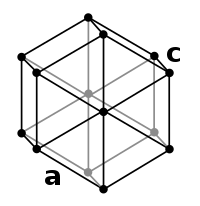
Photo from wikipedia
5-Hydroxymethylfurfural (5-HMF) has been described as one of the 12 key platform molecules derived from biomass by the US Department of Energy, and its hydrogenation reaction produces versatile liquid biofuels… Click to show full abstract
5-Hydroxymethylfurfural (5-HMF) has been described as one of the 12 key platform molecules derived from biomass by the US Department of Energy, and its hydrogenation reaction produces versatile liquid biofuels such as 2,5-dimethylfuran (2,5-DMF). Catalytic hydrogenation from 5-HMF to 2,5-DMF was thoroughly studied on the metal nickel catalysts supported on Al2O3-TiO2-ZrO2 (Ni/ATZ) mixed oxides using isopropanol and formic acid (FA) as hydrogen donors to find the best conditions of the reaction and hydrogen donor. The influence of metal content (wt%), Ni particle size (nm), Nickel Ni0, Ni0/NiO and NiO species, metal active sites and acid-based sites on the catalyst surface, and the effect of the hydrogen donor (isopropanol and formic acid) were systematically studied. The structural characteristics of the materials were studied using different physicochemical methods, including N2 physisorption, XRD, Raman, DRS UV-Vis, FT-IR, SEM, FT-IR Pyad, H2-TPD, CO2-TPD, H2-TPR, TEM and XPS. Second-generation 2,5-DMF biofuel and 5-HMF conversion by-products were analyzed and elucidated using 1H NMR. It was found that the Ni0NiO/ATZ3WI catalyst synthesized by the impregnation method (WI) generated a good synergistic effect between the species, showing the best catalytic hydrogenation of 5-HMF to 2,5-DMF using formic acid as a hydrogen donor for 24 h of reaction and temperature of 210 °C with 20 bar pressure of Argon (Ar).
Journal Title: Molecules
Year Published: 2022
Link to full text (if available)
Share on Social Media: Sign Up to like & get
recommendations!